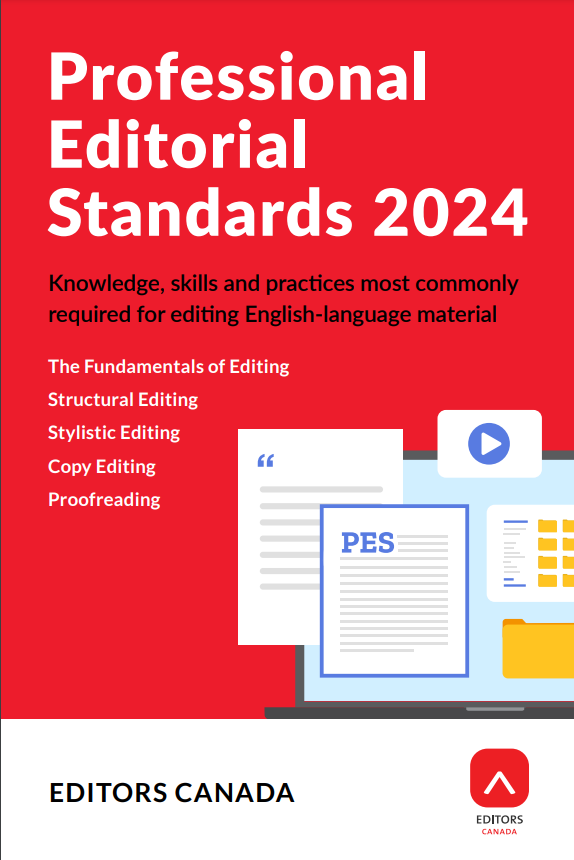Editors Canada's updated Professional Editorial Standards move our profession forward.
A brief primer on how to lower your standards
 We editors are perfectionists, so it may seem odd to introduce the topic of lowering standards. After all, it’s our job to uphold the very highest of standards as articulated in Professional Editorial Standards, a publication of Editors Canada.
We editors are perfectionists, so it may seem odd to introduce the topic of lowering standards. After all, it’s our job to uphold the very highest of standards as articulated in Professional Editorial Standards, a publication of Editors Canada.
But who among us hasn’t been faced with a client who doesn’t allow for such perfection? Either because there is not enough time, or money, or even desire to edit or proofread to the standard we know every publication deserves? What then?
Over the course of my career, I’ve had to compromise quality many times, sometimes at the direct request of the client. When I worked in-house on self-help books that were printed in short runs and regularly updated when regulatory changes demanded new or revised material, we were able to rationalize cutting corners because we knew small errors would be corrected in the next edition. The publisher’s expectation was that print deadlines were never to be missed. Period. That early training thickened my skin to discovering typos in books that slipped through after I’d signed off on them. Of course, I still cringed, and hung my head … but then moved on.
A few years ago, WCEA worked on a multi-book project editing dozens of open content publications—books that others were allowed to distribute, remix, tweak, and build upon without the author’s direct permission. The budget was small and the pressure to get the books to market was huge. We branded the project as “good enough editing,” which was an apt description of how many times we had to let things go, shrugging our shoulders and saying, “Oh well. Good enough.” Yes, we lowered our standards, but we upheld our commitment to provide what was asked of us from an excellent client.
More recently, one of my long-time and favourite clients set out some tough (lower) standards for editing and proofreading their annual report. The goal was to reduce the huge amount of in-house time the annual project ate up in order to leave more time to work on other more important priorities. And the reality is that the document—the committee report section in particular—was read by only a few, finding its way into the recycling bin minutes after the annual general meeting was concluded. My instructions from the client? “We need to Marie Kondo the shit out of this thing!”
I laughed when I read that email, and then began following Kondo’s approach: I “decluttered” anything in the report that didn’t “spark joy.” Deleting mangled passages was way faster than fixing them. And I admit that the entire process this year was much more joyful than in the past when I often cursed the amount of work required in a compressed timeline.
So what’s the best approach when you’re faced with the need to lower your standards? A “Kondo edit” may not always be appropriate, so here I offer five suggestions for how to lower your standards while maintaining your professionalism.
- Prioritize the levels of editing needed, and edit to the highest priority that time, budget, or the client allows. A simple list from highest to lowest priority might be 1) correct errors in punctuation, grammar, and spelling; 2) correct improper word usage; 3) make sentences more effective.
- Delete what you can. Don’t spend time rewriting meaningless phrases or tangled sentences if the document will stand without them.
- Make your decisions from the reader’s point of view, not from your highest-of-standards-editor point of view. That means you may have to ignore something that you want to change but know won’t bother the reader. Judith Tarutz makes a good case for this approach in her book Technical Editing: The Practical Guide for Editors and Writers.
- Choose your battles. If an author or client questions or rejects some of your changes, don’t waste time revisiting the issue unless an egregious error remains.
- Before you begin your work, always, always, always be clear with your client what you can and cannot do under the parameters set. Then restate those limitations when you hand in your finished work.
For more ideas, you can check out Amy Einsohn’s excellent discussion on “editorial triage” in her book The Copyeditor’s Handbook. And take heart with the knowledge that every editor has to face the task of lowering standards some time in their career. Doing so may not spark joy, but you can take satisfaction in knowing you’ve done your best work possible for the particular job.
This Post Has 4 Comments
Comments are closed.




Hi Ruth, I’m a perfectionist, and I think perfectionism is an occupational hazard for many editors! Your post is a refreshing reminder that a) we are human and b) it’s not always worth our time or the client’s money to strive for perfection. Would it be okay if I link to your post in my course at Queen’s, WRIT 265: Editing in Academic and Professional Contexts? I’m updating the course now for the fall class.
Thanks,
Ellie Barton
Thanks for your comments, Ellie. I’m happy to have you share the link to this post with your students!
Ruth
Oh, neat idea, “Marie Kondo”ing the words. I just love taking dense heavy passages and slimming them down to leave some white space.
It’s amazing how many procedures we editors have devised to help our colleagues spot and annihilate clutter! Sometimes it’s a little more complicated than spotting the cobwebs in the corner, but that’s what makes it so fun to share strategies.
Thanks, Christa, for weighing in. Yes, I think clearing clutter and creating white space is way more satisfying than “real” housecleaning (at least, for me!).
I look forward to hearing more from you on developing this important skill in your upcoming Editors Canada webinar. Readers, check it out: “Aie! Not Enough Time: How to Do Quick & Dirty Corporate Edits.”
You can register at http://training.editors.ca/upcoming_webinar/aie-not-enough-time-how-to-do-quick-dirty-corporate-edits/